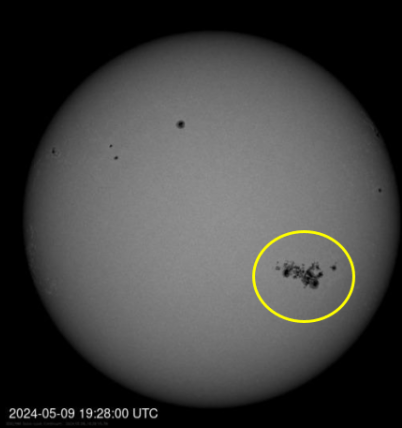The most severe geomagnetic storm of the past 20 years is expected to hit Earth on Friday night, which could impact power grid systems, navigation and radio and satellite communication. But the upside to this rare event is that Canadians across the country may be able to see a spectacular display of aurora borealis.
The U.S.’s National Oceanic and Atmospheric Administration (NOAA), which tracks space weather events, is anticipating that northern lights could be seen as far south as northern California and Alabama. The geomagnetic storm may last throughout the weekend.
The northern lights will “likely be visible across Canada where the sky is clear on Friday night and then again potentially on Saturday night,” according to Global News meteorologist Anthony Farnell.
“For best viewing, you should try to get away from the bright city lights and look to the north. With the intensity of this event, the northern lights could even be directly overhead and bright enough to be seen even in major cities,” he added.
Given that we’re “just coming off the new moon,” the light of the moon is not expected to interfere with tonight’s aurora, Farnell said.
Most parts of B.C., Alberta and Saskatchewan look to have a clear or mostly clear cloud forecast for tonight. People in southern Manitoba around Winnipeg are also in luck.
As for eastern Canada, most of Ontario looks cloudy expect for pockets around the Greater Toronto area. Southern Quebec looks to be clear or mostly clear, along with Labrador. Unfortunately, the Maritime provinces may miss out on the light show.
The geomagnetic storm watch was issued on Thursday after space weather forecasters observed “several moderate to strong” solar flares exploding off the Sun, produced by a massive cluster of sunspots.
The cluster is about 16 times the diameter of the Earth and can be seen by the human eye through eclipse glasses (if you got a pair for the April 8 eclipse, break them out).

At least five coronal mass ejections, in other words, massive clouds of magnetized particles, appear to be hurtling towards Earth. When they arrive, after travelling around 15-18 hours to make it to Earth, they could disrupt critical infrastructure.
In 2003, an “extreme” geomagnetic storm caused power outages in Sweden and damaged power transformers in South Africa.
Friday’s geomagnetic storm is anticipated to be a “severe” G4 event, on a scale of G1 being the most minor to G5 being the most extreme, though it could possibly register as a “low G5” event, said NOAA space weather forecaster Shawn Dahl during a Friday press conference.
More on Canada
Dahl said NOAA is “a little concerned” about the potential disruptive impacts of the geomagnetic storm, and that the event “warranted special attention.” The danger of such storms is that they can induce electric currents in the power grid, which can cause shorts and outages. They can also impact satellites in orbit, which are responsible for communication and GPS navigation.
“As far as the worst situation expected here at Earth, that’s tough to say and I wouldn’t want to speculate on that,” Dahl said. “However, severe level is pretty extraordinary, It’s a very rare event to happen.”
Robyn Fiori, a scientist at the Canadian Hazard Information Service, pointed out that a strong geomagnetic storm caused a large power outage at Hydro-Quebec in 1989, but today’s storm isn’t likely to down any power grids.
“(Power system operators) know what’s going on. They have a lot of experience, knowing what their systems can handle, modelling what their systems can handle, and understanding space weather impacts,” she said.
While the storm won’t impact cellphone communication, it could disrupt ham radio, which Fiori notes is used for communication between communities in northern Canada.
“It’ll also impact aviation, and maritime users as well. They both use high frequency communications, often as a secondary system,” Fiori said.
In general however, “the biggest thing and most visible manifestation of space weather is the aurora,” said Robert Steenburgh, another NOAA space forecaster who presented at the Friday news conference.
“If you happen to be in an area where it’s dark and cloud-free and relatively unpolluted by light, you may get to see a fairly impressive aurora display. And that’s really the gift of space weather.”
If you’re unable to see the aurora with your naked eye, you may be able to see it through your camera, Steenburgh added.
“Just to aim it at the sky and take a picture,” he said. “You may be surprised when you look at that image later.”
— with files from Global News’ Kyle Benning
© 2024 Global News, a division of Corus Entertainment Inc.



